+ Open data
Open data
- Basic information
Basic information
| Entry |  | |||||||||
|---|---|---|---|---|---|---|---|---|---|---|
| Title | Cryo-EM Structure of the KBTBD2-CUL3-Rbx1 dimeric complex | |||||||||
 Map data Map data | ||||||||||
 Sample Sample |
| |||||||||
 Keywords Keywords | ligase / complex | |||||||||
| Function / homology |  Function and homology information Function and homology informationpositive regulation of mitotic cell cycle phase transition / trophectodermal cellular morphogenesis / liver morphogenesis / POZ domain binding / nuclear protein quality control by the ubiquitin-proteasome system / polar microtubule / regulation protein catabolic process at postsynapse / COPII vesicle coating / anaphase-promoting complex-dependent catabolic process / cullin-RING-type E3 NEDD8 transferase ...positive regulation of mitotic cell cycle phase transition / trophectodermal cellular morphogenesis / liver morphogenesis / POZ domain binding / nuclear protein quality control by the ubiquitin-proteasome system / polar microtubule / regulation protein catabolic process at postsynapse / COPII vesicle coating / anaphase-promoting complex-dependent catabolic process / cullin-RING-type E3 NEDD8 transferase / NEDD8 transferase activity / cullin-RING ubiquitin ligase complex / positive regulation of mitotic metaphase/anaphase transition / RHOBTB3 ATPase cycle / embryonic cleavage / Cul7-RING ubiquitin ligase complex / cell projection organization / ubiquitin-dependent protein catabolic process via the C-end degron rule pathway / cellular response to chemical stress / Loss of Function of FBXW7 in Cancer and NOTCH1 Signaling / positive regulation of protein autoubiquitination / RNA polymerase II transcription initiation surveillance / protein neddylation / Notch binding / fibroblast apoptotic process / NEDD8 ligase activity / RHOBTB1 GTPase cycle / negative regulation of response to oxidative stress / VCB complex / Cul5-RING ubiquitin ligase complex / SCF ubiquitin ligase complex / negative regulation of type I interferon production / ubiquitin-ubiquitin ligase activity / stem cell division / SCF-dependent proteasomal ubiquitin-dependent protein catabolic process / Cul2-RING ubiquitin ligase complex / mitotic metaphase chromosome alignment / Cul3-RING ubiquitin ligase complex / Cul4A-RING E3 ubiquitin ligase complex / negative regulation of Rho protein signal transduction / Cul4-RING E3 ubiquitin ligase complex / stress fiber assembly / negative regulation of mitophagy / positive regulation of cytokinesis / Prolactin receptor signaling / Cul4B-RING E3 ubiquitin ligase complex / ubiquitin ligase complex scaffold activity / cullin family protein binding / protein monoubiquitination / endoplasmic reticulum to Golgi vesicle-mediated transport / sperm flagellum / RHOBTB2 GTPase cycle / ubiquitin-like ligase-substrate adaptor activity / protein K48-linked ubiquitination / protein autoubiquitination / Nuclear events stimulated by ALK signaling in cancer / gastrulation / transcription-coupled nucleotide-excision repair / positive regulation of TORC1 signaling / regulation of cellular response to insulin stimulus / negative regulation of insulin receptor signaling pathway / intrinsic apoptotic signaling pathway / post-translational protein modification / cyclin binding / T cell activation / Regulation of BACH1 activity / positive regulation of protein ubiquitination / integrin-mediated signaling pathway / cellular response to amino acid stimulus / Degradation of DVL / kidney development / phosphatidylinositol 3-kinase/protein kinase B signal transduction / Degradation of GLI1 by the proteasome / GSK3B and BTRC:CUL1-mediated-degradation of NFE2L2 / Negative regulation of NOTCH4 signaling / G1/S transition of mitotic cell cycle / Recognition of DNA damage by PCNA-containing replication complex / negative regulation of canonical Wnt signaling pathway / Hedgehog 'on' state / Vif-mediated degradation of APOBEC3G / FBXL7 down-regulates AURKA during mitotic entry and in early mitosis / Degradation of GLI2 by the proteasome / GLI3 is processed to GLI3R by the proteasome / response to insulin / RING-type E3 ubiquitin transferase / protein destabilization / Degradation of beta-catenin by the destruction complex / DNA Damage Recognition in GG-NER / Oxygen-dependent proline hydroxylation of Hypoxia-inducible Factor Alpha / Evasion by RSV of host interferon responses / NOTCH1 Intracellular Domain Regulates Transcription / lipid metabolic process / Dual Incision in GG-NER / Transcription-Coupled Nucleotide Excision Repair (TC-NER) / Constitutive Signaling by NOTCH1 PEST Domain Mutants / Constitutive Signaling by NOTCH1 HD+PEST Domain Mutants / Formation of TC-NER Pre-Incision Complex / Regulation of expression of SLITs and ROBOs / Wnt signaling pathway / Formation of Incision Complex in GG-NER Similarity search - Function | |||||||||
| Biological species |  Homo sapiens (human) Homo sapiens (human) | |||||||||
| Method | single particle reconstruction / cryo EM / Resolution: 3.96 Å | |||||||||
 Authors Authors | Sun L / Chen Z / Hu Y / Mao Q | |||||||||
| Funding support |  China, 1 items China, 1 items
| |||||||||
 Citation Citation |  Journal: Nat Struct Mol Biol / Year: 2024 Journal: Nat Struct Mol Biol / Year: 2024Title: Dynamic molecular architecture and substrate recruitment of cullin3-RING E3 ligase CRL3. Authors: Yuxia Hu / Zhao Zhang / Qiyu Mao / Xiang Zhang / Aihua Hao / Yu Xun / Yeda Wang / Lin Han / Wuqiang Zhan / Qianying Liu / Yue Yin / Chao Peng / Eva Marie Y Moresco / Zhenguo Chen / Bruce Beutler / Lei Sun /   Abstract: Phosphatidylinositol 3-kinase α, a heterodimer of catalytic p110α and one of five regulatory subunits, mediates insulin- and insulin like growth factor-signaling and, frequently, oncogenesis. ...Phosphatidylinositol 3-kinase α, a heterodimer of catalytic p110α and one of five regulatory subunits, mediates insulin- and insulin like growth factor-signaling and, frequently, oncogenesis. Cellular levels of the regulatory p85α subunit are tightly controlled by regulated proteasomal degradation. In adipose tissue and growth plates, failure of K48-linked p85α ubiquitination causes diabetes, lipodystrophy and dwarfism in mice, as in humans with SHORT syndrome. Here we elucidated the structures of the key ubiquitin ligase complexes regulating p85α availability. Specificity is provided by the substrate receptor KBTBD2, which recruits p85α to the cullin3-RING E3 ubiquitin ligase (CRL3). CRL3 forms multimers, which disassemble into dimers upon substrate binding (CRL3-p85α) and/or neddylation by the activator NEDD8 (CRL3~N8), leading to p85α ubiquitination and degradation. Deactivation involves dissociation of NEDD8 mediated by the COP9 signalosome and displacement of KBTBD2 by the inhibitor CAND1. The hereby identified structural basis of p85α regulation opens the way to better understanding disturbances of glucose regulation, growth and cancer. | |||||||||
| History |
|
- Structure visualization
Structure visualization
| Supplemental images |
|---|
- Downloads & links
Downloads & links
-EMDB archive
| Map data |  emd_34199.map.gz emd_34199.map.gz | 192.4 MB |  EMDB map data format EMDB map data format | |
|---|---|---|---|---|
| Header (meta data) |  emd-34199-v30.xml emd-34199-v30.xml emd-34199.xml emd-34199.xml | 20.8 KB 20.8 KB | Display Display |  EMDB header EMDB header |
| Images |  emd_34199.png emd_34199.png | 77 KB | ||
| Filedesc metadata |  emd-34199.cif.gz emd-34199.cif.gz | 7.1 KB | ||
| Others |  emd_34199_half_map_1.map.gz emd_34199_half_map_1.map.gz emd_34199_half_map_2.map.gz emd_34199_half_map_2.map.gz | 171.1 MB 171.1 MB | ||
| Archive directory |  http://ftp.pdbj.org/pub/emdb/structures/EMD-34199 http://ftp.pdbj.org/pub/emdb/structures/EMD-34199 ftp://ftp.pdbj.org/pub/emdb/structures/EMD-34199 ftp://ftp.pdbj.org/pub/emdb/structures/EMD-34199 | HTTPS FTP |
-Validation report
| Summary document |  emd_34199_validation.pdf.gz emd_34199_validation.pdf.gz | 637.1 KB | Display |  EMDB validaton report EMDB validaton report |
|---|---|---|---|---|
| Full document |  emd_34199_full_validation.pdf.gz emd_34199_full_validation.pdf.gz | 636.7 KB | Display | |
| Data in XML |  emd_34199_validation.xml.gz emd_34199_validation.xml.gz | 15.3 KB | Display | |
| Data in CIF |  emd_34199_validation.cif.gz emd_34199_validation.cif.gz | 18.3 KB | Display | |
| Arichive directory |  https://ftp.pdbj.org/pub/emdb/validation_reports/EMD-34199 https://ftp.pdbj.org/pub/emdb/validation_reports/EMD-34199 ftp://ftp.pdbj.org/pub/emdb/validation_reports/EMD-34199 ftp://ftp.pdbj.org/pub/emdb/validation_reports/EMD-34199 | HTTPS FTP |
-Related structure data
| Related structure data | 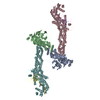 8gq6MC 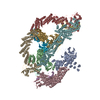 8h33C 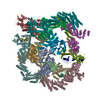 8h34C 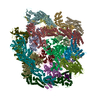 8h35C 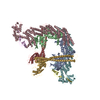 8h36C  8h37C  8h38C  8h3aC  8h3fC 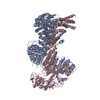 8h3qC 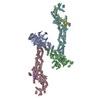 8h3rC M: atomic model generated by this map C: citing same article ( |
|---|---|
| Similar structure data | Similarity search - Function & homology  F&H Search F&H Search |
- Links
Links
| EMDB pages |  EMDB (EBI/PDBe) / EMDB (EBI/PDBe) /  EMDataResource EMDataResource |
|---|---|
| Related items in Molecule of the Month |
- Map
Map
| File |  Download / File: emd_34199.map.gz / Format: CCP4 / Size: 216 MB / Type: IMAGE STORED AS FLOATING POINT NUMBER (4 BYTES) Download / File: emd_34199.map.gz / Format: CCP4 / Size: 216 MB / Type: IMAGE STORED AS FLOATING POINT NUMBER (4 BYTES) | ||||||||||||||||||||||||||||||||||||
|---|---|---|---|---|---|---|---|---|---|---|---|---|---|---|---|---|---|---|---|---|---|---|---|---|---|---|---|---|---|---|---|---|---|---|---|---|---|
| Projections & slices | Image control
Images are generated by Spider. | ||||||||||||||||||||||||||||||||||||
| Voxel size | X=Y=Z: 1.332 Å | ||||||||||||||||||||||||||||||||||||
| Density |
| ||||||||||||||||||||||||||||||||||||
| Symmetry | Space group: 1 | ||||||||||||||||||||||||||||||||||||
| Details | EMDB XML:
|
-Supplemental data
-Half map: #2
| File | emd_34199_half_map_1.map | ||||||||||||
|---|---|---|---|---|---|---|---|---|---|---|---|---|---|
| Projections & Slices |
| ||||||||||||
| Density Histograms |
-Half map: #1
| File | emd_34199_half_map_2.map | ||||||||||||
|---|---|---|---|---|---|---|---|---|---|---|---|---|---|
| Projections & Slices |
| ||||||||||||
| Density Histograms |
- Sample components
Sample components
-Entire : KBTBD2-CUL3-Rbx1 dimeric complex
| Entire | Name: KBTBD2-CUL3-Rbx1 dimeric complex |
|---|---|
| Components |
|
-Supramolecule #1: KBTBD2-CUL3-Rbx1 dimeric complex
| Supramolecule | Name: KBTBD2-CUL3-Rbx1 dimeric complex / type: complex / ID: 1 / Parent: 0 / Macromolecule list: #1-#3 |
|---|---|
| Source (natural) | Organism:  Homo sapiens (human) Homo sapiens (human) |
-Macromolecule #1: Kelch repeat and BTB domain-containing protein 2
| Macromolecule | Name: Kelch repeat and BTB domain-containing protein 2 / type: protein_or_peptide / ID: 1 / Number of copies: 2 / Enantiomer: LEVO |
|---|---|
| Source (natural) | Organism:  Homo sapiens (human) Homo sapiens (human) |
| Molecular weight | Theoretical: 71.403367 KDa |
| Recombinant expression | Organism:  |
| Sequence | String: MSTQDERQIN TEYAVSLLEQ LKLFYEQQLF TDIVLIVEGT EFPCHKMVLA TCSSYFRAMF MSGLSESKQT HVHLRNVDAA TLQIIITYA YTGNLAMNDS TVEQLYETAC FLQVEDVLQR CREYLIKKIN AENCVRLLSF ADLFSCEELK QSAKRMVEHK F TAVYHQDA ...String: MSTQDERQIN TEYAVSLLEQ LKLFYEQQLF TDIVLIVEGT EFPCHKMVLA TCSSYFRAMF MSGLSESKQT HVHLRNVDAA TLQIIITYA YTGNLAMNDS TVEQLYETAC FLQVEDVLQR CREYLIKKIN AENCVRLLSF ADLFSCEELK QSAKRMVEHK F TAVYHQDA FMQLSHDLLI DILSSDNLNV EKEETVREAA MLWLEYNTES RSQYLSSVLS QIRIDALSEV TQRAWFQGLP PN DKSVVVQ GLYKSMPKFF KPRLGMTKEE MMIFIEASSE NPCSLYSSVC YSPQAEKVYK LCSPPADLHK VGTVVTPDND IYI AGGQVP LKNTKTNHSK TSKLQTAFRT VNCFYWFDAQ QNTWFPKTPM LFVRIKPSLV CCEGYIYAIG GDSVGGELNR RTVE RYDTE KDEWTMVSPL PCAWQWSAAV VVHDCIYVMT LNLMYCYFPR SDSWVEMAMR QTSRSFASAA AFGDKIFYIG GLHIA TNSG IRLPSGTVDG SSVTVEIYDV NKNEWKMAAN IPAKRYSDPC VRAVVISNSL CVFMRETHLN ERAKYVTYQY DLELDR WSL RQHISERVLW DLGRDFRCTV GKLYPSCLEE SPWKPPTYLF STDGTEEFEL DGEMVALPPV UniProtKB: Kelch repeat and BTB domain-containing protein 2 |
-Macromolecule #2: E3 ubiquitin-protein ligase RBX1
| Macromolecule | Name: E3 ubiquitin-protein ligase RBX1 / type: protein_or_peptide / ID: 2 / Number of copies: 2 / Enantiomer: LEVO / EC number: RING-type E3 ubiquitin transferase |
|---|---|
| Source (natural) | Organism:  Homo sapiens (human) Homo sapiens (human) |
| Molecular weight | Theoretical: 13.970756 KDa |
| Recombinant expression | Organism:  |
| Sequence | String: HHHHHHENLY FQGMAAAMDV DTPSGTNSGA GKKRFEVKKW NAVALWAWDI VVDNCAICRN HIMDLCIECQ ANQASATSEE CTVAWGVCN HAFHFHCISR WLKTRQVCPL DNREWEFQKY GH UniProtKB: E3 ubiquitin-protein ligase RBX1 |
-Macromolecule #3: Cullin-3
| Macromolecule | Name: Cullin-3 / type: protein_or_peptide / ID: 3 / Number of copies: 2 / Enantiomer: LEVO |
|---|---|
| Source (natural) | Organism:  Homo sapiens (human) Homo sapiens (human) |
| Molecular weight | Theoretical: 90.105469 KDa |
| Recombinant expression | Organism:  |
| Sequence | String: WSHPQFEKMS NLSKGTGSRK DTKMRIRAFP MTMDEKYVNS IWDLLKNAIQ EIQRKNNSGL SFEELYRNAY TMVLHKHGEK LYTGLREVV TEHLINKVRE DVLNSLNNNF LQTLNQAWND HQTAMVMIRD ILMYMDRVYV QQNNVENVYN LGLIIFRDQV V RYGCIRDH ...String: WSHPQFEKMS NLSKGTGSRK DTKMRIRAFP MTMDEKYVNS IWDLLKNAIQ EIQRKNNSGL SFEELYRNAY TMVLHKHGEK LYTGLREVV TEHLINKVRE DVLNSLNNNF LQTLNQAWND HQTAMVMIRD ILMYMDRVYV QQNNVENVYN LGLIIFRDQV V RYGCIRDH LRQTLLDMIA RERKGEVVDR GAIRNACQML MILGLEGRSV YEEDFEAPFL EMSAEFFQME SQKFLAENSA SV YIKKVEA RINEEIERVM HCLDKSTEEP IVKVVERELI SKHMKTIVEM ENSGLVHMLK NGKTEDLGCM YKLFSRVPNG LKT MCECMS SYLREQGKAL VSEEGEGKNP VDYIQGLLDL KSRFDRFLLE SFNNDRLFKQ TIAGDFEYFL NLNSRSPEYL SLFI DDKLK KGVKGLTEQE VETILDKAMV LFRFMQEKDV FERYYKQHLA RRLLTNKSVS DDSEKNMISK LKTECGCQFT SKLEG MFRD MSISNTTMDE FRQHLQATGV SLGGVDLTVR VLTTGYWPTQ SATPKCNIPP APRHAFEIFR RFYLAKHSGR QLTLQH HMG SADLNATFYG PVKKEDGSEV GVGGAQVTGS NTRKHILQVS TFQMTILMLF NNREKYTFEE IQQETDIPER ELVRALQ SL ACGKPTQRVL TKEPKSKEIE NGHIFTVNDQ FTSKLHRVKI QTVAAKQGES DPERKETRQK VDDDRKHEIE AAIVRIMK S RKKMQHNVLV AEVTQQLKAR FLPSPVVIKK RIEGLIEREY LARTPEDRKV YTYVA UniProtKB: Cullin-3 |
-Macromolecule #4: ZINC ION
| Macromolecule | Name: ZINC ION / type: ligand / ID: 4 / Number of copies: 6 / Formula: ZN |
|---|---|
| Molecular weight | Theoretical: 65.409 Da |
-Experimental details
-Structure determination
| Method | cryo EM |
|---|---|
 Processing Processing | single particle reconstruction |
| Aggregation state | particle |
- Sample preparation
Sample preparation
| Buffer | pH: 7.8 |
|---|---|
| Vitrification | Cryogen name: ETHANE |
- Electron microscopy
Electron microscopy
| Microscope | FEI TITAN KRIOS |
|---|---|
| Image recording | Film or detector model: GATAN K2 SUMMIT (4k x 4k) / Detector mode: SUPER-RESOLUTION / Average electron dose: 45.0 e/Å2 |
| Electron beam | Acceleration voltage: 300 kV / Electron source:  FIELD EMISSION GUN FIELD EMISSION GUN |
| Electron optics | Illumination mode: FLOOD BEAM / Imaging mode: BRIGHT FIELD / Nominal defocus max: 2.2 µm / Nominal defocus min: 1.2 µm |
| Experimental equipment |  Model: Titan Krios / Image courtesy: FEI Company |
 Movie
Movie Controller
Controller
































 Z (Sec.)
Z (Sec.) Y (Row.)
Y (Row.) X (Col.)
X (Col.)





































